
Before the rain nearly drowned our spirits in New York Tuesday, we hit two shows that were surprises to us–Brian Alfred at (shown, his “Endless City”, acrylic on canvas, 72″ x 144″) Max Protetch and Thomas Demand at 303 Gallery.
Alfred was a surprise to me, but clearly not to the art world, since at the age of 28 this young artist was having his fourth solo show at Protetch, and his third in three years.
 His dreamy landscapes start in the world we live in and get processed and translated via computer to iconic cyber-representations of the world–the world that Alfred lives in, I guess–that are dreamy and sad.
His dreamy landscapes start in the world we live in and get processed and translated via computer to iconic cyber-representations of the world–the world that Alfred lives in, I guess–that are dreamy and sad.

The work has an Alex Katz-like, reductive, billboard quality, without the people (shown, Katz’s “Walk”). Somehow, Alfred comments on our society, but unlike Katz, he’s not commenting on a specific social class or human interaction. Rather, he’s commenting on THE SITUATION.
 In large acrylic paintings, small collages (one shown here)and video (the sound accompanying the video was by musician Lullatone, CDs for sale at $5 each), Alfred’s eye captures the irony in the billboards, the cool affect of the architectural spaces we inhabit, the processed landscapes of our lives. He focuses on the traces of the human endeavor with its creators and users all disappeared.
In large acrylic paintings, small collages (one shown here)and video (the sound accompanying the video was by musician Lullatone, CDs for sale at $5 each), Alfred’s eye captures the irony in the billboards, the cool affect of the architectural spaces we inhabit, the processed landscapes of our lives. He focuses on the traces of the human endeavor with its creators and users all disappeared.
 We’re looking into the computer–and the painting and the video and the collages (another shown here)–and seeing reflections of our own minds. The dose of reality from nature is also processed until it reflects us, not what’s really out there. Our infrastructure–roads, water pipes, telephone wires, skyscrapers, and computer wires have taken over.
We’re looking into the computer–and the painting and the video and the collages (another shown here)–and seeing reflections of our own minds. The dose of reality from nature is also processed until it reflects us, not what’s really out there. Our infrastructure–roads, water pipes, telephone wires, skyscrapers, and computer wires have taken over.
 His brief video, “Overload,” with the techno-hum soundtrack, moves dreamily from scene to scene, with the reflection of a dirigible drifting across the mirrored face of a modern skyscraper, or an almost menacing number of highways looming overhead (shown below), or tall building silhouettes dreamily rising up from the bottom of the frame, then their windows lighting up and then the whole scene disappearing.
His brief video, “Overload,” with the techno-hum soundtrack, moves dreamily from scene to scene, with the reflection of a dirigible drifting across the mirrored face of a modern skyscraper, or an almost menacing number of highways looming overhead (shown below), or tall building silhouettes dreamily rising up from the bottom of the frame, then their windows lighting up and then the whole scene disappearing.

This is our so-called life.
I wanted to pop some money on one of the little collages (How much can they possibly cost? I asked myself). The answer exceeded $2,000. Alas. I didn’t buy.
Secrets and lies

Alfred’s beautiful, but sad little world talked directly to the next show we visited, Thomas Demand, a German artist whose work we had seen at the Carnegie International in 1999 in Pittsburgh.
 Demand creates objects or spaces out of construction paper and then photographs them to question reality, photographic images, the eye. He’s master of the big lie. It’s hard to figure that what you’re seeing in these gorgeous, giant photos is the real thing or not or worse or better.
Demand creates objects or spaces out of construction paper and then photographs them to question reality, photographic images, the eye. He’s master of the big lie. It’s hard to figure that what you’re seeing in these gorgeous, giant photos is the real thing or not or worse or better.
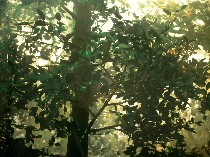
The wow of the show was “Clearing” (above and details left and right), a chromagenic print of a recreation of a forest scene big enough–72 inches high, 195 wide–to walk in. The lit up tree trunks and leaves, some lit with green light, some with yellow, were believable at first glance and inviting and plain old beautiful.
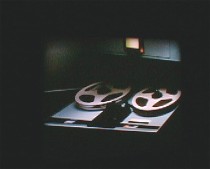 The video, “Recorder,” a film of an old eight-track tape recorder, its reels spinning, had music that had a similar, techno-hum to the music at Protetch. The shaking camera added to the old-fashioned technology’s affect, and I had no idea it was a reconstruction until I moved further into the exhibit. In the still shown, however, the realism breaks apart a little.
The video, “Recorder,” a film of an old eight-track tape recorder, its reels spinning, had music that had a similar, techno-hum to the music at Protetch. The shaking camera added to the old-fashioned technology’s affect, and I had no idea it was a reconstruction until I moved further into the exhibit. In the still shown, however, the realism breaks apart a little.
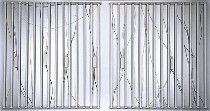 “Lightbox,” which showed the interior lightbulbs inside, was more believable and kept right on being believable, almost to the point of disbelief that it was an illusion. Only a crease in one of the lightbulbs and the flatness of the wires gave it away.
“Lightbox,” which showed the interior lightbulbs inside, was more believable and kept right on being believable, almost to the point of disbelief that it was an illusion. Only a crease in one of the lightbulbs and the flatness of the wires gave it away.
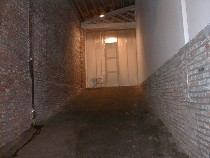 We saw only three photographs and a video at 303 Gallery, (the fourth photo, “Kitchen,” a recreation from a photo of Saddam Hussein’s hideaway, was inaccessible the day we were there), but they had me questioning reality by time I was done — the glitzy gallery front windows, the weird entrance doors to boutiques, the weird anti-glitz of another gallery (shown, the entrance to Gasser & Grunert, where Bambi and the birds resided — see Roberta’s prior post).
We saw only three photographs and a video at 303 Gallery, (the fourth photo, “Kitchen,” a recreation from a photo of Saddam Hussein’s hideaway, was inaccessible the day we were there), but they had me questioning reality by time I was done — the glitzy gallery front windows, the weird entrance doors to boutiques, the weird anti-glitz of another gallery (shown, the entrance to Gasser & Grunert, where Bambi and the birds resided — see Roberta’s prior post).
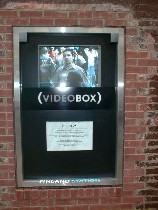 And weirder yet, at the end of the day, once we were totally soaked, outside Whitebox Gallery, right in the brick wall was this video, “The Pallasades 05-01-01,” by Beat Streuli, which had shown at Arcadia University’s gallery last year. It was on display for only one day–the day Roberta and I were there in New York. And it was pretty gritty and real, kind of like the street we were standing on. And then again not.
And weirder yet, at the end of the day, once we were totally soaked, outside Whitebox Gallery, right in the brick wall was this video, “The Pallasades 05-01-01,” by Beat Streuli, which had shown at Arcadia University’s gallery last year. It was on display for only one day–the day Roberta and I were there in New York. And it was pretty gritty and real, kind of like the street we were standing on. And then again not.









